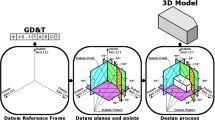Abstract
The existence of holes in meshes makes it difficult for mesh operations, especially when comes to model rebuilding, rapid prototyping and finite element analysis. Existing hole-filling algorithms are capable of filling holes on small and smooth regions of a model. For large holes with complex boundaries or in curved region, they may not result in satisfactory results. This paper proposes an algorithm which first split the holes into flatter ones and then split the complex holes based the concept of edge expansion. It incrementally splits a complex hole into simple ones by respecting the 3D shape of its boundary and the neighboring meshes, and then fills each resulting simple hole with planar triangulation. The proposed algorithm works well for a variety of complex holes and can better preserve the detailed features of the original mesh.











Similar content being viewed by others
References
Levin A (1999) Filling an N-sided hole using combined subdivision schemes. In: Curves and surfaces proceedings, pp 221–228
Chui C, Lai M-J (2000) Filling polygonal holes using C1 cubic triangular spline patches. Comput Aided Geom Des 17(4):297–307
Curless B, Levoy M (1996) A volumetric method for building complex models from range image. In: Computer graphics (Proc SIGGRAPH) 30, pp 303–312
Carr J, Beatson R., Cherrie J, Mitchell T, Fright W, McCallum B (2001) Reconstruction and representation of 3D objects with radial basis functions In: Computer graphics (Proc SIGGRAPH), pp 67–76
Liepa P (2003) Filling holes in meshes. In: Eurographics symposium on geometric processing, pp 200–207
Jun Y (2005) A piecewise hole filling algorithm in reverse engineering. Comput Aided Des 37(2):263–270
David C-S, Jean-Marie M (2003) Restricted Delaunay triangulations and normal cycle. In: Proceedings of the 19th annual symposium on computational geometry, pp 312–321
Erkki Oja (1989) Neural networks, principal components, and subspaces. Int J Neural Syst 1(1):61–68
Girod B, Greiner G, Niemann H (2000) Principles of 3D image analysis and synthesis. Kluwer, Dordrecht
Dey Tk (1992) Delaunay triangulations in three dimensions with finite precision arithmetic. Comput Aided Geom Des 9(6):457–470
Lee DT (1980) Two algorithms for constructing a Delaunay triangulation. Int J Comput Inf Sci 9(3):219–242
Lee DT (1986) Generalized Delaunay triangulation for planar graphs. Discrete Comput Geom 1:201–217
Boidssinnat JD (1988) Shape reconstruction from planar sections. Comput Vis Graph Image Proc 44(1):1–29
Piegl LA (1993) Algorithm and data structure for triangulation multiply connected polygonal domains. Comput Graph 14(5):563–574
Floriani LD (1992) An online algorithm for constrained Delaunay triangulation. Graph Models Image Process 54(3):290–300
Sloan SW (1987) A fast algorithm for constructing Delaunay triangulation in the plane. Adv Eng Softw 9(1):34–55
Perrin DP, Ladd AM, Kavraki LE, Howe RD, Cannon JW (2005) Fast intersection checking for parametric deformable models 5747:1468–1474
Lin H-W, Tai C-L, Wang G-J (2004) A mesh reconstruction algorithm driven by an intrinsic property of a point cloud. Comput Aided Des 36(1):1–9
Zhang X, Zhou M, Guohua G (2003) A method of detecting the edge of triangular mesh surface (in Chinese). J Image Graph 8(10):1223–1226
Acknowledgments
This work was supported by the National Natural Science Foundation of China under Grant No. 60473106; the National Natural Science Foundation of China under Grant No. 60333010; the National Research Foundation for the Doctoral Program of Higher Education of China under Grant No. 20060335114.
Author information
Authors and Affiliations
Corresponding author
Rights and permissions
About this article
Cite this article
Li, G., Ye, XZ. & Zhang, SY. An algorithm for filling complex holes in reverse engineering. Engineering with Computers 24, 119–125 (2008). https://doi.org/10.1007/s00366-007-0075-9
Received:
Accepted:
Published:
Issue Date:
DOI: https://doi.org/10.1007/s00366-007-0075-9




